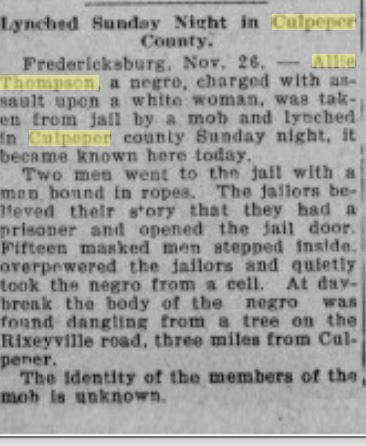How did Virginia Newspapers utilize communication to brutalize African American?
Atta Gould
In addition to understanding how the actions of these newspapers posed a threat, it’s imperative to build an understanding of the rhetoric utilized to incite violence. In the reconstruction era that followed emancipation, governments across the country formulated new systems to oppress and suppress black folk. In 1870 Virginia courts ruled that schools would be segregated, and by 1973, the state code stated that any white person marrying a black person would be jailed and fined. [1] The laws emplaced upheld a superiority complex that birthed the United States. In addition, systems from slavery only evolved. Many of the laws inflicted upon African Americans were enacted with the intent to provide African Americans with below the bare minimum. But, the increased amount of laws posed against black people created an unsustainable atmosphere where blackness in itself was practically illegal. These sorts of segregationist laws not only segregated black people from the rest of America but also perpetuated the stigmatization of black people. There were a plethora of different ideologies utilized to degrade African Americans driving from these laws. But this authoritative anti-blackness wasn’t just limited to government laws. This was also perpetuated by newspapers. From the 1830s, when newspapers began to circulate, newspaper publications would make note of local crimes. But the reconstruction period was a time of opportunity for newspapers to capitalize.
Newspapers directed their attention to crimes, and many of these crimes were supposedly committed by black people. In the wake of these, lynchings skyrocketed. Lynchings had taken place in America for decades. However, between 1880 and 1940, lynchings reached new heights.[2]And Virginia was no exception; between 1880 and 1930, eighty-six men were lynched, only 15 of them were non-African Americans. [3] White Americans used lynching as a form of correcting wrongs and asserting control after previously owning the legal rights of African Americans. Newspapers began highlighting these crimes that, in many cases, hadn’t taken place, specifically stories of black men assaulting white men. Not only did newspapers report the crimes, but they also reported on the lynching. The repeated coverage of these lynchings not only normalized the activity but created a spectacle of it. In addition, Virginia newspapers also encouraged barbarity. On February 3rd of, 1880, the Richmond Dispatch posted published a newspaper article about a man named Page Wallace, a man accused of assaulting a white woman. The headline read, “A VIRGINIA NE*** WHO WILL BE LYNCHED IF CAPTURED.” By predicting the oncoming lynching, the article already assumes guilt. It also calls for the lynching to take place. Additionally, the communication surrounding the lynchings and crimes of African American people was only a piece of the rhetorical tactics used to enact communicative injustice against Black Americans. Virginia newspapers commonly referred to black people with derogatory terms to describe their race. In the November 30th, 1819 publications of The Richmond Dispatch, News Leader, and the December 5th, 1819 Altavista Journal, they report on the lynching of an African American man named Allie Thompson. In all three of the publishings, his name is only mentioned once. Instead, he’s commonly referred to by terms marking his racial identity, such as African American and ne***. The overuse of these terms completely leaves out the fact that Allie Thompson is a male mudding the facts of the story and hyper-focusing on the racial identity of the individual.
[1] Tunnell, Contributor: Ted. “Newspapers in Virginia during the Civil War, Confederate.” Encyclopedia Virginia, December 7, 2020. https://encyclopediavirginia.org/entries/newspapers-in-virginia-during-the-civil-war-confederate/.
[2] “Jim Crow Laws: Virginia Code, Colored, Constitution, Descendant, Felony, Intermarriage, Legislature, Mulatto, Negro, Nurse, Ordinance, Penal Code, Public Transportation, Railroads, Schools, Segregation, Separate but Equal, Slavery, Statute, Supreme Court, Voting, Waiting Rooms.” AmericansAll. Accessed May 10, 2023. https://americansall.org/legacy-story-group/jim-crow-laws-virginia.
[3] “Lynching in America: Confronting the Legacy of Racial Terror.” Lynching in America: Confronting the Legacy of Racial Terror. Accessed May 10, 2023. https://lynchinginamerica.eji.org/report/.
